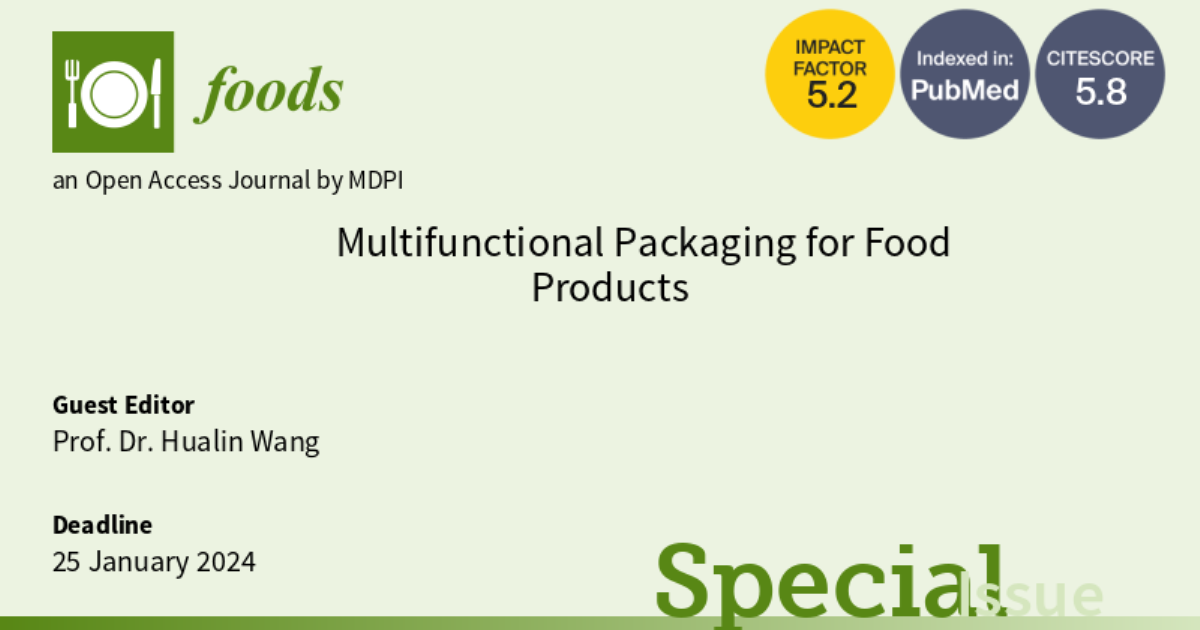Multifunctional Packaging for Food Products
A special issue of Foods (ISSN 2304-8158). This special issue belongs to the section "Food Packaging and Preservation".
Deadline for manuscript submissions: closed (25 August 2024) | Viewed by 3222

Special Issue Editor
Interests: active and intelligent packaging; food preservation; encapsulation and controlled release of active compounds; shelf life extension; food safety
Special Issues, Collections and Topics in MDPI journals
Special Issue Information
Dear Colleagues,
Diversification and personalized demands of consumer markets have driven the development of multifunctional food packaging materials with active and sustainable characteristics, such as barrier and antibacterial activities, monitoring of freshness and spoilage and oxygen scavenging capacity. There is high demand to develop simple, fast, and accurate materials for maintaining storage quality. The biomass-derived films have attracted interest as potential food packaging. Nevertheless, their poor physicochemical properties (e.g., mechanical and water vapor permeable properties) limit the scope of possible applications. Functional materials (e.g., natural and synthetic nanoclays, metal oxide nanoparticles, natural pigments, essential oil) have been introduced into biomass matrices to fabricate multifunctional biomass-derived films, thus improving their packaging performance. Developing advanced multifunctional packaging materials to prolong the shelf-life of food is of importance for improving social and economic benefits.
Therefore, this Special Issue on “Multifunctional Packaging for Food Products” invites researchers to submit their original research articles, comprehensive reviews, or mini reviews with the aim of improving food quality.
Prof. Dr. Hualin Wang
Guest Editor
Manuscript Submission Information
Manuscripts should be submitted online at www.mdpi.com by registering and logging in to this website. Once you are registered, click here to go to the submission form. Manuscripts can be submitted until the deadline. All submissions that pass pre-check are peer-reviewed. Accepted papers will be published continuously in the journal (as soon as accepted) and will be listed together on the special issue website. Research articles, review articles as well as short communications are invited. For planned papers, a title and short abstract (about 250 words) can be sent to the Editorial Office for assessment.
Submitted manuscripts should not have been published previously, nor be under consideration for publication elsewhere (except conference proceedings papers). All manuscripts are thoroughly refereed through a single-blind peer-review process. A guide for authors and other relevant information for submission of manuscripts is available on the Instructions for Authors page. Foods is an international peer-reviewed open access semimonthly journal published by MDPI.
Please visit the Instructions for Authors page before submitting a manuscript. The Article Processing Charge (APC) for publication in this open access journal is 2900 CHF (Swiss Francs). Submitted papers should be well formatted and use good English. Authors may use MDPI's English editing service prior to publication or during author revisions.
Keywords
- intelligent packaging
- antioxidant
- antibacterial
- freshness indicator
- release control
- shelf life
Benefits of Publishing in a Special Issue
- Ease of navigation: Grouping papers by topic helps scholars navigate broad scope journals more efficiently.
- Greater discoverability: Special Issues support the reach and impact of scientific research. Articles in Special Issues are more discoverable and cited more frequently.
- Expansion of research network: Special Issues facilitate connections among authors, fostering scientific collaborations.
- External promotion: Articles in Special Issues are often promoted through the journal's social media, increasing their visibility.
- Reprint: MDPI Books provides the opportunity to republish successful Special Issues in book format, both online and in print.
Further information on MDPI's Special Issue policies can be found here.






